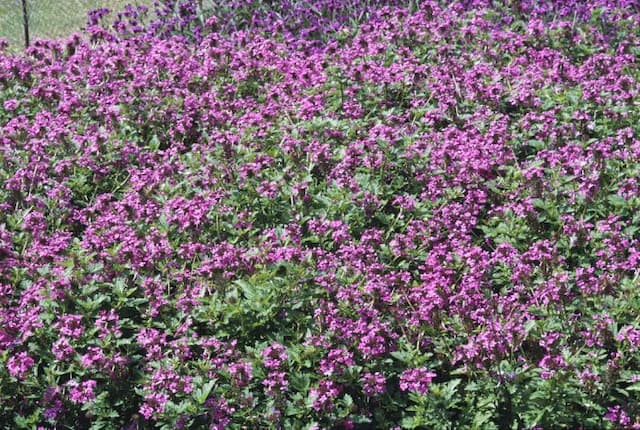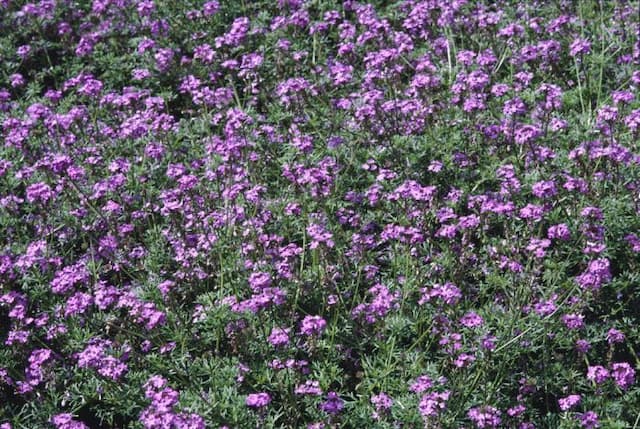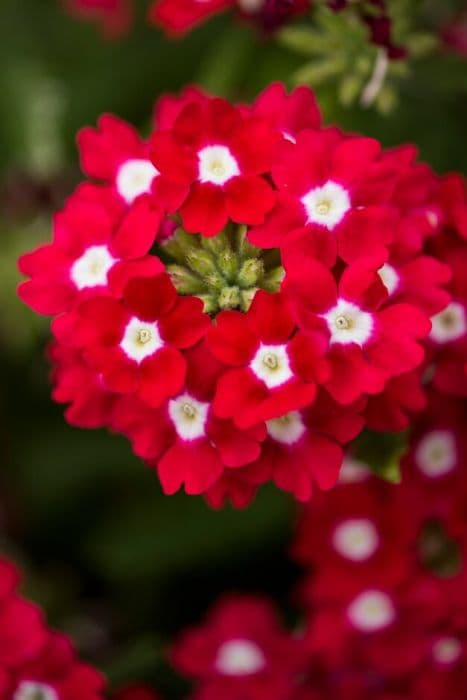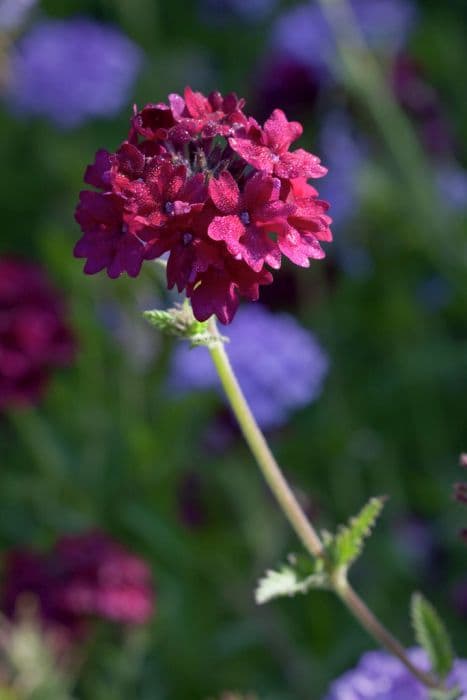Moss Verbena Glandularia 'Peaches 'n' Cream'

ABOUT
The Glandularia 'Peaches 'n' Cream', commonly known as the verbena, is an ornamental plant recognized for its beautiful, colorful flowers. This verbena cultivar bears clusters of delicate blossoms that display a captivating blend of peach and cream hues, which can give a soft, warm appearance to any garden setting. The flowers are small, with a trumpet-like shape, and grow in tight, rounded clusters atop the foliage. The leaves of the Peaches 'n' Cream verbena are usually dark green, with a textured surface that may feel slightly rough to the touch. They are generally narrow and oblong with a lance-like shape, often showing serrated edges. The foliage creates a lush backdrop that allows the creamy peach flowers to stand out dramatically. The overall appearance of the Peaches 'n' Cream verbena is that of a vibrant, low-growing plant that spills generously over the edges of containers or spreads across the ground in a garden bed, giving it a relaxed, yet full and abundant look. Its colorful blossoms are a favorite for attracting butterflies and hummingbirds, adding another layer of dynamism to its display. As a whole, this plant exudes a sense of joyful exuberance and is valued for its long blooming season, bringing continuous color and life to gardens from spring to fall.
About this plant
 Names
NamesFamily
Verbenaceae
Synonyms
Moss Verbena, Garden Verbena, South American Mock Vervain
Common names
Glandularia 'Peaches 'n' Cream'.
 Toxicity
ToxicityTo humans
The Glandularia 'Peaches 'n' Cream', commonly known as garden verbena, is not typically considered toxic to humans. There are no well-documented cases of poisoning from ingesting garden verbena, and it is usually regarded as safe. However, as with any plant, individual allergic reactions or sensitivities may occur, so it is generally advised not to consume any plant material that is not known to be edible.
To pets
Garden verbena is not known to be toxic to pets. It is not listed as a poisonous plant to dogs or cats by major animal health organizations. As with humans, ingestion of garden verbena should not cause any symptoms of poisoning in pets. Although the risk of toxicity is low, it is always wise to prevent pets from eating ornamental plants to avoid any potential stomach upset or allergic reactions.
 Characteristics
CharacteristicsLife cycle
Perennials
Foliage type
Deciduous
Color of leaves
Green
Flower color
Mixed
Height
1 foot (0.3 meters)
Spread
2 feet (0.6 meters)
Plant type
Herb
Hardiness zones
Varies
Native area
Americas
Benefits
 General Benefits
General Benefits- Aesthetic Appeal: Adds vibrant color and texture to gardens with its peach and cream-colored flowers.
- Low Maintenance: Generally easy to care for and does not require much upkeep, making it suitable for busy gardeners.
- Drought Tolerance: Once established, it can withstand periods of low water, making it suitable for xeriscaping.
- Attracts Pollinators: The flowers typically attract bees, butterflies, and other beneficial pollinators, supporting local ecosystems.
- Adaptive Growth: Can thrive in a variety of soil types, provided they are well-draining.
- Rapid Growth: Quick to establish and spread, filling in garden spaces efficiently.
- Continuous Blooming: Known for its long flowering season, offering color in garden spaces for extended periods.
- Compact Size: Ideal for smaller gardens, borders, and containers due to its moderate growth habit.
- Deer Resistance: Less palatable to deer than other garden plants, which can be an advantage in areas with deer pressure.
 Medical Properties
Medical PropertiesThis plant is not used for medical purposes.
 Air-purifying Qualities
Air-purifying QualitiesThis plant is not specifically known for air purifying qualities.
 Other Uses
Other Uses- Companion Planting: Glandularia can be planted alongside vegetable crops to enhance their growth by attracting beneficial insects such as pollinators and predatory insects that feed on crop pests.
- Artistic Inspiration: The vibrant colors and patterns of 'Peaches 'n' Cream' can be used as inspiration for artists and designers looking to capture the beauty of nature in their work.
- Educational Tool: This plant can be used in schools or educational programs to teach about botany, plant life cycles, and the importance of pollinators in ecosystems.
- Natural Dye: The petals of Glandularia could be boiled to create natural dyes for coloring fabrics or other materials in shades of pink, peach, or cream.
- Photography Subject: Its striking appearance makes 'Peaches 'n' Cream' a popular subject for photographers practicing macro photography or nature photography.
- Culinary Garnish: Edible flowers like Glandularia can add a splash of color and a subtle flavor twist when used as a garnish for salads and desserts, though it is important to ensure that the flowers have not been treated with pesticides and are safe for consumption.
- Garden Aromatherapy: The plant can be strategically placed in a garden where its light fragrance is released into the air, creating a calming and pleasant atmosphere for relaxation and stress relief.
- Crafts and Decor: Dried flowers of Glandularia can be used for making natural potpourri, or in crafting activities like making bookmarks, greeting cards, or pressed flower art.
- Theme Gardens: The soft hues of 'Peaches 'n' Cream' make it a perfect addition to thematic gardens, such as a pastel-colored garden or a Victorian-style cottage garden.
- Erosion Control: When planted in masses on slopes, Glandularia can help prevent soil erosion thanks to its root system holding the soil in place.
Interesting Facts
 Feng Shui
Feng ShuiThe Glandularia, commonly known as verbena, is not typically used in Feng Shui practice.
 Zodiac Sign Compitability
Zodiac Sign CompitabilityThe verbena is not used in astrology practice.
 Plant Symbolism
Plant Symbolism- Beauty and Grace - The Glandularia 'Peaches 'n' Cream', commonly known as verbena, often represents beauty and grace due to its delicate, intricate blossoms that exhibit a soft, pleasing color palette.
- Healing - Verbena has a history of being used in traditional herbal medicine, symbolizing healing and the restoration of physical and emotional wellbeing.
- Creativity - With its vibrant and soft hues, verbena can be seen as a symbol of creativity and inspiration, encouraging one to approach life with an artistic and imaginative spirit.
- Harmony - The gentle blend of 'Peaches 'n' Cream' colors can signify balance and harmony, reminding us of the beauty of blended qualities and peaceful coexistence.
- Attraction - Verbena's alluring scent and form have been historically thought to attract love and positivity, symbolizing magnetism and the power of allure.
 Water
WaterFor the common garden verbena, 'Peaches 'n' Cream', water thoroughly when the top inch of soil feels dry to the touch, which typically means watering once every week. However, frequency may increase during hot, dry periods to possibly twice a week. Provide enough water to saturate the root zone. A general rule is to use approximately one gallon of water for each watering per plant, ensuring you're not just wetting the surface but reaching deeper soil layers.
 Light
LightGarden verbena 'Peaches 'n' Cream' thrives in full sunlight, requiring at least six hours of direct sunlight daily. Position the plant in a spot where it can receive ample morning light and continuous sunshine throughout the day to promote the best flowering. Though it can tolerate partial shade, too little light can lead to sparser blooms and leggy growth.
 Temperature
TemperatureGarden verbena 'Peaches 'n' Cream' prefers warm temperatures and is generally hardy in USDA zones 7 through 11. It can endure minimum temperatures of around 0 degrees Fahrenheit but thrives best between 60 and 80 degrees Fahrenheit. Prolonged exposure to temperatures below freezing can severely damage or kill the plant.
 Pruning
PruningPrune garden verbena 'Peaches 'n' Cream' to maintain its shape and encourage bushier growth. Deadheading spent blooms throughout the growing season can promote more flowering. Perform more extensive pruning in the early spring or late fall by cutting back overgrown stems to about one-third of their length, which helps in rejuvenation and ensures robust growth in the following season.
 Cleaning
CleaningAs needed
 Soil
SoilThe best soil mix for the verbena 'Peaches 'n' Cream' is a well-draining, fertile mix with added organic matter such as peat moss or compost. A soil pH slightly acidic to neutral, ranging from 6.0 to 7.0, is ideal for this plant.
 Repotting
RepottingVerbena 'Peaches 'n' Cream' generally doesn't require frequent repotting and can be repotted every other year or when it outgrows its current pot, to refresh the soil and provide room for growth.
 Humidity & Misting
Humidity & MistingVerbena 'Peaches 'n' Cream' thrives at average ambient humidity levels but can tolerate lower humidity environments. No specific humidity level is necessary for this adaptable plant.
 Suitable locations
Suitable locationsIndoor
Provide bright light and well-drained soil for verbena 'Peaches 'n' Cream' indoors.
Outdoor
Plant in full sun and well-draining soil for outdoor verbena 'Peaches 'n' Cream'.
Hardiness zone
6-11 USDA
 Life cycle
Life cycleGlandularia 'Peaches 'n' Cream', commonly known as Verbena, begins its life cycle when the seeds germinate in warm, moist soil conditions, sprouting into seedlings. The seedlings develop into vegetative plants with characteristic foliage and begin to establish a root system. As the plants mature, they enter the flowering stage, producing clusters of peach and cream colored blooms that attract pollinators such as bees and butterflies. Following pollination, the flowers develop into fruit that contains seeds, completing the reproductive phase. At the end of the growing season, Verbena may die back, especially in cooler climates, but it can also behave as a perennial in warmer zones, where it will enter a period of dormancy before initiating a new growth cycle in the spring. In some cases, gardeners can propagate Verbena through cuttings, bypassing the seed stage and creating clones of the parent plant that will go through similar growth stages.
 Propogation
PropogationPropogation time
Spring to Summer
Glandularia 'Peaches 'n' Cream', commonly known as a variety of verbena, is often propagated through stem cuttings, which is the most popular method for this plant. To propagate via stem cuttings, one should ideally take cuttings in the spring or early summer when the plant is actively growing. Choose a healthy, non-flowering stem and make a cut about 4-6 inches (10-15 cm) long, just below a leaf node. Remove the leaves from the lower half of the stem to avoid rotting when planted. Dip the cut end in rooting hormone to increase the chances of successful rooting and plant the cutting in a pot filled with a well-draining soil mix. Keep the soil consistently moist but not waterlogged and in a warm environment with plenty of indirect sunlight until the cutting has rooted, which typically takes several weeks. Once the roots are established, the new verbena plant can be transplanted to its permanent location.
![Vervain [Donalena Lavender Grace]](/_next/image?url=https%3A%2F%2Fplants-admin.emdemapps.com%2Fimages%2Fplants%2F%2Fimages%2F604b575c837e7.png&w=640&q=75)




![Vervain [Endurascape Pink Bicolor]](/_next/image?url=https%3A%2F%2Fplants-admin.emdemapps.com%2Fimages%2Fplants%2F%2Fimages%2F604b594e749b0.png&w=640&q=75)

![Vervain [Seabrook's Lavender]](/_next/image?url=https%3A%2F%2Fplants-admin.emdemapps.com%2Fimages%2Fplants%2F%2Fimages%2F604b650ea9729.png&w=640&q=75)

